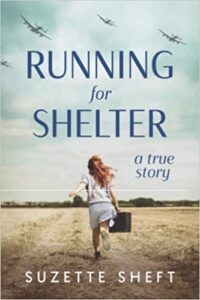Running for Shelter
Suzette Sheft
Amsterdam
Published November 9, 2022
Amazon | Bookshop | Goodreads
About Running for Shelter
Vienna, late 1930s. Bright, red-headed Inge Eisenger leads a privileged life with her glamorous, distant mother. When forced to flee from Nazi-occupied Austria to Switzerland, Inge sees her young life turned upside down. She hopes to finally connect with her mother during their escape, but her mother soon abandons her. Vulnerable and alone, Inge makes her way to Paris before reuniting with her grandmother in Central France. But even there, Inge endures one hardship after another—all while her grandmother keeps a family secret that, if revealed, could result in their whole family’s demise.
RUNNING FOR SHELTER is written by Inge’s 15-year-old granddaughter, Suzette Sheft. The gripping, true story offers a window through which young adult readers can witness the challenges of growing up during the Holocaust. As this important chapter of history fades from living memory, Inge’s tale offers hope to a new generation who must also cultivate courage and determination in the face of personal and political challenges.
My Review
I love that the author chose this way to honor her dad, who passed away when she was thirteen, but whose interest in family history inspired her own. And to honor her grandmother, whose life story this book is based upon. What a cool tribute to them both.
Each chapter begins with a date, helping to anchor the reader in the timeline of not only the story, but also in history. The story begins in 1937 and ends in 1946, so it covers almost a decade, which is pretty much half of Inge’s life at that point.
So many people were part of Inge’s journey through the war. It was cool seeing the way communities pulled together and/or went into survival mode as war threatened them. Some scenes felt really filled out, and it was easy to imagine myself in them. Others seemed to move more quickly and left me with questions.
I was a little bit confused by the marketing of the book. It didn’t read like a nonfiction title or list sources in the way I would have expected, but the subtitle flags the story as true. The publisher lists it as a novel based on a true story, which is what it felt like reading it.
On the whole, I thought this was an intense story about a young Jewish girl’s struggle for survival in Europe during World War II. I hadn’t read anything deeply similar to Inge’s experience, so I’m glad to have broadened my understanding of that period of history.
Content Notes for Running for Shelter
Recommended for Ages 12 up.
Representation
Inge Eisenger is Jewish and Austrian.
Profanity/Crude Language Content
None.
Romance/Sexual Content
A man hired to transport Inge to France rapes her. It’s not described on scene, but the lead up is pretty harrowing.
Spiritual Content
For a long time, Inge does not know she’s Jewish as she was raised by a nonpracticing mother.
Violent Content
See sexual content. Inge learns a friend was killed by a German bomb.
Drug Content
None.
Note: This post contains affiliate links, which do not cost you anything to use, but which help support this blog. I received a free copy of RUNNING FOR SHELTER in exchange for my honest review.
